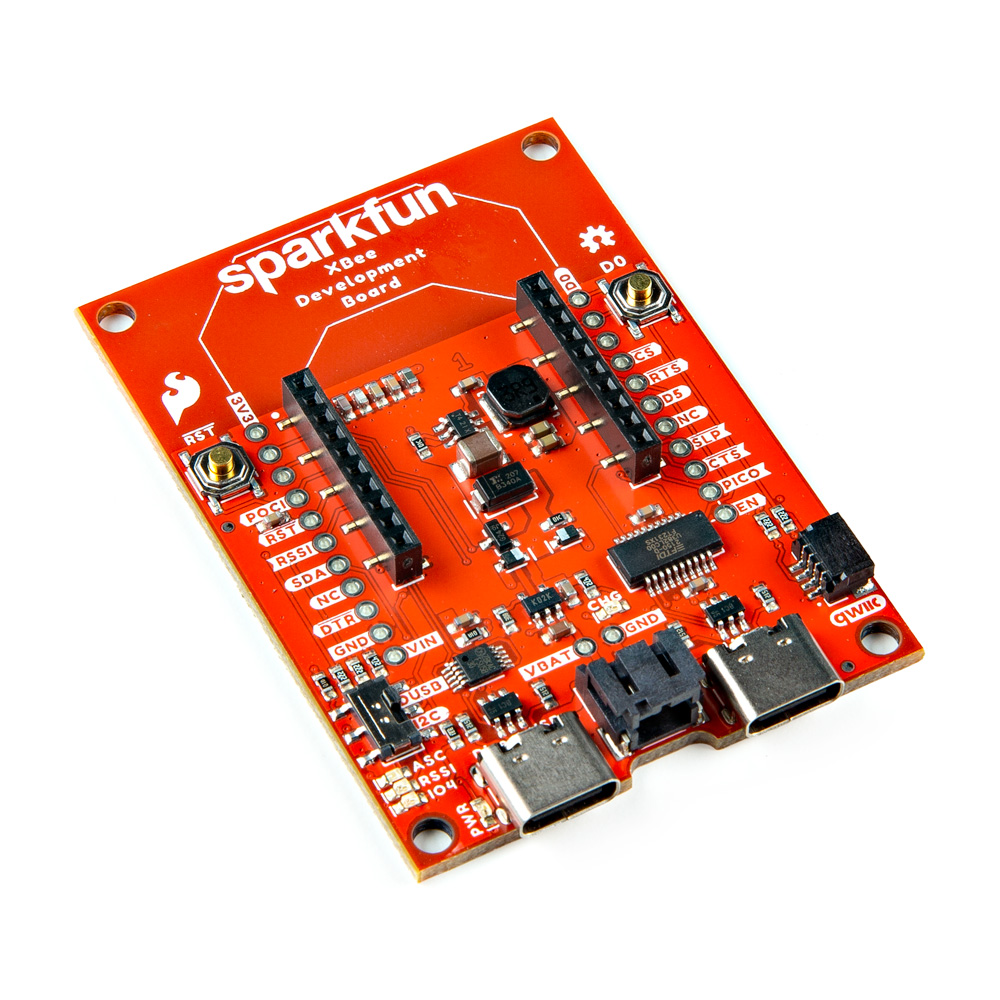SparkFun Digi XBee® Development Board
The SparkFun Digi XBee® Development Board is designed to help you quickly and easily prototype low-power cellular IoT applications using the new Digi XBee 3 Low-Power LTE-M/NB-IoT, Digi XBee RR. With the SparkFun Digi XBee® Development Board, you will be able to build wireless applications using Digi XBee modules, including LTE cellular, Zigbee, LoRaWAN, 900/868MHz, DigiMesh, and any other through-hole Digi XBee module. This board breaks out all the functionality of your XBee module with support for the power requirements of cellular modules and a full design review from Digi Engineering.
The XBee Development Board makes it possible to build sensor networks for remote monitoring, control devices wirelessly from your PC, prototype real-time data acquisition systems, and more! This is a "kitchen sink" development board that gives you access to the pin functionality of the XBee, includes two USB-C connectors for UART communication and firmware updates, a Qwiic connector for I2C capable sensors and peripherals, as well as Reset and D0 buttons and the ability to update firmware on the XBees that have cellular modules. There's also a JST port for a battery to allow your project to be more on the go and stay on the go with its battery charging capabilities.
Digi Remote Manager® allows users to easily configure and control devices from a central platform. Built-in Digi TrustFence® security, identity, and data privacy features use multiple layers of control to protect against new and evolving cyber threats. Standard XBee API frames and AT commands, MicroPython, and Digi XBee Studio simplify setup, configuration, testing and adding or changing functionality.
The SparkFun Qwiic Connect System is an ecosystem of I2C sensors, actuators, shields and cables that make prototyping faster and less prone to error. All Qwiic-enabled boards use a common 1mm pitch, 4-pin JST connector. This reduces the amount of required PCB space, and polarized connections mean you can’t hook it up wrong.
- On-board Digi XBee 3 20-pin through-hole socket
- Configurable via XBee Studio, Digi Remote Manager, XCTU or AT command
- AP63203 Buck converter (up to 2A)
- FT231XS USB to UART bridge
- 1x Qwiic connector
- Up to 6V supply voltage
- 3x indicator LEDs
- Reset and D0 buttons
- 2-pin JST charge circuit connector for single cell, LiPo batteries
- Schematic
- Eagle Files
- Board Dimensions
- Hookup Guide
- XBee 3 LTE Cat 1 User Guide (Digi)
- XBee Buying Guide
- Qwiic Info Page
- GitHub Hardware Repo
Copyright Notice: Digi XBee® and XBee® are registered trademarks of Digi International Inc.
SparkFun Digi XBee® Development Board Product Help and Resources
Core Skill: Programming
If a board needs code or communicates somehow, you're going to need to know how to program or interface with it. The programming skill is all about communication and code.
Skill Level: Competent - The toolchain for programming is a bit more complex and will examples may not be explicitly provided for you. You will be required to have a fundamental knowledge of programming and be required to provide your own code. You may need to modify existing libraries or code to work with your specific hardware. Sensor and hardware interfaces will be SPI or I2C.
See all skill levels
Core Skill: Electrical Prototyping
If it requires power, you need to know how much, what all the pins do, and how to hook it up. You may need to reference datasheets, schematics, and know the ins and outs of electronics.
Skill Level: Rookie - You may be required to know a bit more about the component, such as orientation, or how to hook it up, in addition to power requirements. You will need to understand polarized components.
See all skill levels
Comments
Looking for answers to technical questions?
We welcome your comments and suggestions below. However, if you are looking for solutions to technical questions please see our Technical Assistance page.
Customer Reviews
No reviews yet.






